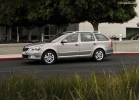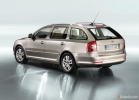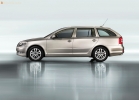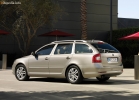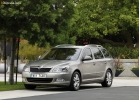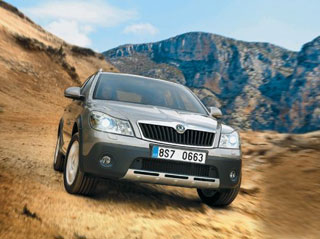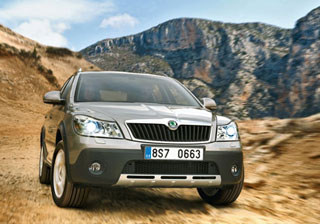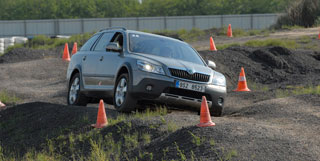Skoda Octavia Combi test drive since 2008 -
Carriage
Places and drive to the maximumIt just so happened that in our market there were almost simultaneously two cars, close in purpose and oriented to the same group of customers. They seemed to ask for comparison with each other.
The all -terrain version of Mazda6 Wagon presented at the end of last year has already managed to recruit the first for and against it when she appeared in peak as a capacious and no less all -wheel drive Skoda Octavia Combi 4x4.
Who is what
Mazda6 Wagon 4wd
The price of a tested car is $ 38 300
Max. Power 162 l. With. at 6500 vol./min.
Max. speed 190 km/h
Acceleration 0-100 km/h 12.2 s
Skoda Octavia Combi 4x4
The price of a tested car is $ 34,000
Max. Power 150 liters. With. at 6000 rpm/min.
Max. Speed \u200b\u200b202 km/h
Acceleration 0-100 km/h 9.7 s
Mazda6 Wagon 4wd
Under the hood
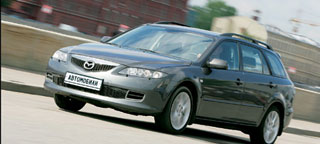
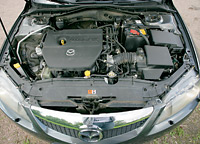
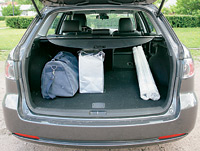
Engine: working volume 2261 cm3,
compression degree 9.7: 1,
max. Power 162 l. With. at 6500 vol./min,
max. moment 205 nm at 4000 rpm/min
Fuel consumption (EPA): 7.8/14.6 liters per 100 km
Fuel tank volume: 64 liters
The number of places 5
The drive is complete
Suspension
The front is independent
The rear is independent
Gearbox ed., 5-st.
Dynamic characteristics
Maximum speed, km/h 190
Acceleration to 100 km/h, from 12.2
common data
Mass equipment., Kg 1591

The amount of cargo in the trunk does not affect the road clearance of clearance is automatically supported by unchanged
Skoda Octavia Combi 4x4
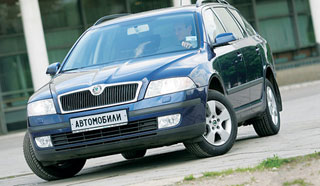
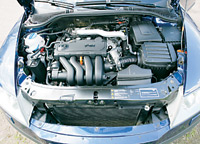
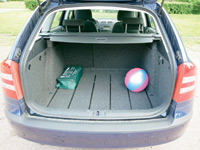
Under the hood
Engine: working volume 1984 cm3,
compression degree 11.5: 1,
max. Power 150 liters. With. at 6000 vol./min,
max. moment 200 nm at 3500 rpm/min
Fuel consumption (EPA): 6.6/11.6 liters per 100 km
Fuel tank volume: 55 l
The number of places 5
The drive is complete
Suspension
The front is independent
The rear is independent
Gearbox ed., 6-st.
Dynamic characteristics
Maximum speed, km/h 202
Acceleration to 100 km/h, from 9.7
common data
A mass of equipment./Full, kg 1430/2090
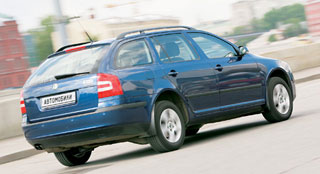
Skoda is associated with the American Station Wagon luggage compartment. Volume varies from 580 to 1620 liters
From this angle, Skoda Octavia looks not just solid, but monumental
Despite the passport 14 cm, the real road clearance is much larger. An important plus if you have to go not only on asphalt
The long names of both beauties are quite consistent with the vast lists of options. Both cars with powerful engines and in decent configuration. Mazda came to us with an automatic transmission, and Skoda on the handle. But since the habits of alternative transmission are well known, we still decided on a comparative test. The pricing and technological roll towards the Mazda was further strengthened and the stabilization system of the road clearance, supporting the rear axle of the six at a constant level, regardless of the load.
ERGONOMICS
The updated Mazda salon liked us at the first appearance of the car.
Moderately soft leather seats are pleasantly in contact with the body, and improved sound insulation promises to extinguish unwanted noises.
Mazda has a very convenient leather three -spoke steering wheel with a set of sound control buttons. The sound itself also pleased. Like visibility, including through mirrors. Big and slightly distorting, they are directly what is needed.
But to a decent barrel of honey, a spoonful of tar is to find our professional duty. The first thing that alerted the moderate tone of the motor is completely overlapped by the noise of the wheels and, oddly enough, pendants, by its sound conveying all the bumps to the salon. However, most likely, wide low -profile wheels are to blame for this, and not a suspension with noise insulation on their own.
The second minus was discovered only after prolonged sitting on the driver's seat. Either the combination of the length with the softness of the pillow is not optimal, or the correct angle of inclination could not be selected in one word, the planting failed. I repeat, however, that in conditions of a dynamically changing city flow, it was absolutely convenient to sit.
The living space of any model of Skoda could always be characterized by two words: practicality and severity. The interior was noticeably cheerful from polished aluminum inserts and a knob of the box.
Skoda leather seats are dense, with excellent support, but some kind of strange, spoon-like shape. The abundance of Volkswagen trifles, of which, as from the designer, is assembled by the Skodov interior, already determines the convenience of using, which was confirmed in practice. Even outwardly, a rather imposing four-spoke steering wheel turned out to be trimmed with excellent skin and just attracts his hands to itself.
How convenient the hook-handle is, for which it is easy to open the hood, the hanging rubber mini-brigade, designed to be a handle for slamming the lid of the trunk, is just as doubtful.
And he completely disappointed the knob of the KP already mentioned in past materials. It looks stylish and very attractive, and it is not convenient to hold its croused hilt from any side.
The sound picture in Octavia at first seemed more favorable, but only until the first sharp overclocking. The quiet, it seems, the FSI-motor climbed into the ears through invisible soundproof traps and regularly reminded of himself with the right foot with a slipper on the floor.
In a word, both machines were not accustomed to protect against acoustic garbage. Although both rivals can adequately compete with him with the help of high -quality musical systems.
In terms of the stock of free space in all directions of the obvious leader, there was no one.
The cars are quite spacious, allow you to transport five large uncles without much damage, and a decent number of suitcases in the trunk.
DYNAMICS
It goes without saying that we did not imply pure dueling races due to differences in transmission. In numbers, analogues are almost identical, so we limited ourselves to the subjective assessments of the behavior of vehicles close in power.
A large Mazda motor is able to issue 162 forces, which is a lot for an almost two -ton barn. By car of this level, the machine is almost necessary. And pretty thoughtful.
If, with smooth acceleration and starting from the place of agility, the box is still enough, then on a suburban highway, especially when overtaking at a speed of a hundred, the slowness of the transmission begins to noticeably irritate. We have to calculate the overtaking phases and drown the pedal in advance.
However, if everything happened, the transmission switched and the motor roared only holding on. It takes away the all -wheel drive Mazda forward excellently, and the higher the engine speed the better.
The manual mode of switching ranges is fundamentally changing the acceleration picture. The station wagon instantly becomes obedient, and the box begins to surprise with the abuse of violent smoking of speeds.
The Mazda slows down very well. Moreover, the brakes of a heavy all -wheel drive machine are not afraid of frequent besiegers from high speeds and are always adequate to press. Everything is wonderful here.
The hundred -fingered Skoda has an enviable renunciation, just have time to pull the handle of the gears. The motor exactly pulls from medium speeds, and the tachometer arrow in low gears quickly approaches the red zone. The traction is quite sufficient, but in the city crowd and, especially, uphill, a noticeable minus was revealed: the smooth first gear forces the driver to decently gasp during touching.
Initidant girls constantly risk or stall, or burn the clutch. Here, the gear rates would be more easier to do.
Skoda brakes are on top. Clear and powerful.
CONTROLLABILITY
For an objective comparison of the tenacities and contrastality of these machines, we categorically lacked ice. Therefore, the case was limited to impromptu lane.
Both cars have connected rear bridges. Both have drive couplings in the rear wheels. Therefore, the result is approximately the same.
Both Mazda6 and Skoda Octavia are quite smoothly beginning to rake with the rear wheels at the slightest feature of the front slipping, and when moving at decent speed, to remove gas and brake wheels, preventing all kinds of demolition and skidding. Perhaps Mazda in this process acts softer and inconspicuous.
Skoda responds a little more sharply to the movements of the steering wheel, but it also begins to swim with the stabilization system. And her electronic stabilizer is sharper.
In the sum of the impressions, approximate parity for all characteristics. Unless Octavia Combi turns the wheels a little cooler.
SUMMARY
These, at first glance, are not very comparable cars are actually very close in basic parameters. The differences in the price are due, as we have already said, are more serious equipment Mazda6 Wagon 4WD. Skoda Octavia Combi 4x4 is more modest, although it is not devoid of personal raisins.
Skoda with its dynamic manners will rather interest a more active part of customers. Mazda6 is more expensive, but it looks just as expensive and is intended for more measured drivers. Personally, my sympathies are on her side, although the final choice always remains for you!
Distribution of the moment
Mazda6 Wagon
The full-wheel drive of our station wagon, a slightly simplified copy of Active Torque Split All-Wheel-Drive, which twists the wheels on the hottest version of the MPS six. The front wheel drive is constant. The disk coupling of the rear axle drive is controlled automatically. Having collected information about the speed of rotation of the wheels, corner of rotation of the steering wheel, pressing the gas pedal, longitudinal and angular accelerations, as well as evaluating the quality of the road surface to slip the wheels, the processor issues the command to connect the coupling. The degree of transmission of power back is determined by the compression force of the clutches and continuously changes, depending on the mode of movement.
With intensive acceleration, exactly half of the torque will go to the rear wheels, and when driving along the motorway, only the front ones will remain driven. In addition, the rear gearbox contains a differential of increased friction that helps to align the torque between the rear wheels. For more accurate control of the distribution of torque, the rear gearbox is equipped with an oil temperature control sensor.
Full -wheel drive electronics are closely related to the dynamic stabilization system, which can be turned off if desired.
Skoda Octavia Combi
Octavia Tour Combi 4x4 is organized similarly to all VW Group vehicles with a transverse engine and its main part has a Haldex coupon installed in the rear gearbox. The drive is connected as soon as the difference in the speed of rotation between the front and rear axle occurs. Moreover, the high -speed coupling begins to transmit the moment to the rear wheels with a difference on the axes of only 15. The Haldex clutches include a continuously working oil pump, hydraulic cylinders, which flow oil pressure through the control valves, and the control unit. Two valves organize the complete or partial compression of the clutches and a similar degree of transmission of the moment backward.
The ESP system also works in a close community with the transmission, which is also entrusted with imitating the locking of wheel differentials. The moment of connecting the rear axle in a slippery turn is felt only with a strongly pressed gas pedal. The stabilization system works quite smoothly.
It is possible to disable ESP, but we will recommend this on slippery coating only experienced drivers with a sober head. On dry asphalt, a machine with disconnected automation slightly deviates from the planned trajectory, as a rule, without causing dangerous sliding to the side.
HOW DO THEY LOOK
Mazda6 Sport Tourer
The first show in Europe 2002,
restyling 2005
Design under the leadership of Swan Callum (Moray Callum)
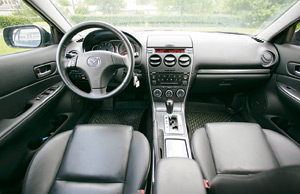
The cozy interior of the interior of the six contributes to distant travel
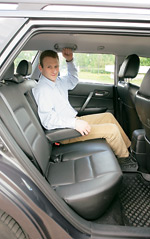
A flat roof over the rear seats and a lot of legs space. A passenger of any complexion will accommodate here comfortably
Skoda Octavia II Combi
The first show of the basic model of 2004,
restyling 2005
Design under the leadership of Thomas Ingenlath.
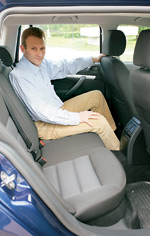
The ceiling above the rear row near Skoda is higher than that of Mazda, and places are smaller. True, it is still quite enough
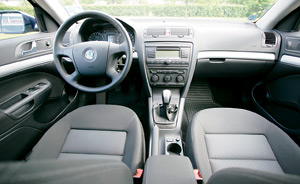
Aluminum inserts introduce the spirit of swiftness into the interior of the salon and correspond to the brisk character of the machine
OUTSIDE
Hot battles for the championship in one of the most densely filled sectors of the European class market with a direct determine the style, armament and appearance of the fighters. As in the life of people, in the life of a car, sport and energy of dynamic and mobile life helps to survive and win. This fact forced Skoda brand managers to add sports tonality to the Octavia model and in a year to acquire RS and update the base model. Plastic and pattern gained the rigidity of the lines and, as a result, began to look more dynamic and energetic. Japanese Mazda has long been feeling in foreign markets confidently largely due to the muscular and sports appearance. In front of this is facilitated by a strong -willed face decorated with a radiant bar on a cladding, which resembles the wings on which a branded emblem soars, and two air intake holes in a memorable silver frame. There is also a fashionably protruding hood, and a slanting, thrown back, eight -eyed optics.
 The face of Octavia is also original and remembered without much stress. A successfully drawn cladding is perceived by an almost historical remake, and the V-shaped relief scattering in the hood spectacularly focuses on the really old and famous emblem. On the side of the Station Wagon type utility are similar by definition, and the nuances of differences are gaining mainly due to deviations from norms and traditions. For example, today is more in fashion than it is dictated by the practicality of the slope of the posterior wall and a dynamic fall back of the roof line. The volume for the luggage does not increase, but adds sharpness to the style.
The face of Octavia is also original and remembered without much stress. A successfully drawn cladding is perceived by an almost historical remake, and the V-shaped relief scattering in the hood spectacularly focuses on the really old and famous emblem. On the side of the Station Wagon type utility are similar by definition, and the nuances of differences are gaining mainly due to deviations from norms and traditions. For example, today is more in fashion than it is dictated by the practicality of the slope of the posterior wall and a dynamic fall back of the roof line. The volume for the luggage does not increase, but adds sharpness to the style. The view of the high -speed station wagon from behind should cause a sense of confidence in its practicality and convenience of transporting cargo. This fully fulfills the design of Octavia. The Mazda6 station wagon adds to this fraction of speed attributes. Well, to quickly deliver yourself to the place and baggage is always preferable than slowly.
INSIDE
Apart from the modest glimpse of silver metal in the decoration and fused with the overlay on the tunnel of the floor of the central console, no more conversation is conducted about the sports orientation of the cars. This is right: it is not good to deceive and most importantly in the design of the station wagon is still practicality. From that and the steering wheel in Octavia about four heavy, but inspiring reliability, and Mazda restrains the flight of the desired image with comparative laconicity.
Owners will have to travel equally often around the city and along the highway and you will have to transport a lot. Therefore, everything looks like that.
SUMMARY
It is possible to expect from the purchase of these cars a radical change in your own image only to someone who parted with the obsessive routine of the sedan. The main thing is that you will have a universal assistant in family affairs and hobbies.
Text Eugene Khapov
Photo by Leonid Grandfather
Source: Cars

